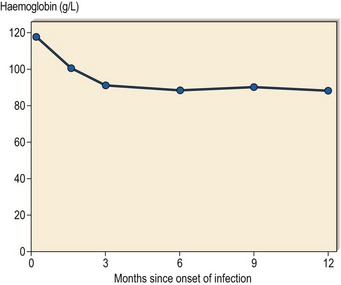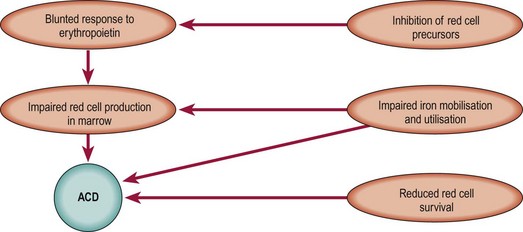18 Anaemia of chronic disease (ACD) is a term used to describe a type of anaemia seen in a wide range of chronic inflammatory, infective and malignant diseases (Table 18.1). The anaemia often becomes apparent during the first few months of illness and then remains fairly constant (Fig 18.1). It is rarely severe (haemoglobin ≥90 g/L; packed cell volume (PCV) ≥0.30) but there is some correlation with the intensity of the underlying illness. For instance, in infection the anaemia is often more marked where there is a persistent fever and in malignancy where there is widespread dissemination. Patients may suffer no symptoms from their anaemia or have only slight fatigue. The importance of this type of anaemia arises not from its severity but from its ubiquity. It is widely misunderstood (for such a common disorder) and ill patients are frequently subjected to excessive haematological investigation and unnecessary treatment with haematinics. The term ACD should not be used to describe other causes of anaemia such as haemolysis or bleeding which may also complicate chronic disorders. It has been argued that the designation ACD is inappropriate but other suggested terms (e.g. anaemia of inflammation) appear even less satisfactory. The anaemia of chronic renal failure is variously referred to as ACD although it has its own specific features (see p. 96). Fig 18.1 ACD in a patient with chronic infection. The causation of the anaemia of chronic disease has been extensively studied but questions remain. Key factors in aetiology are summarised in Figure 18.2. Inflammatory cytokines such as tissue necrosis factor (TNF) and interleukin-1 and -6 are implicated in all of these processes.
Anaemia of chronic disease

The rate of development of anaemia and its final severity are typical of ACD.
Pathophysiology
![]()
Stay updated, free articles. Join our Telegram channel

Full access? Get Clinical Tree


Oncohema Key
Fastest Oncology & Hematology Insight Engine








